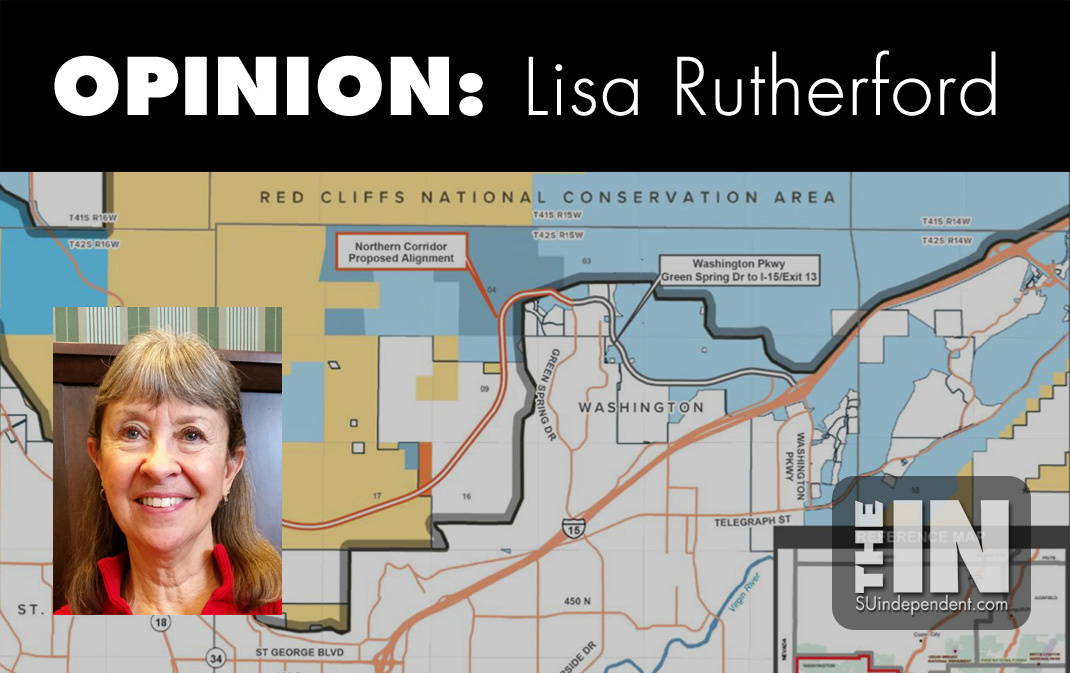
There’s Still Time To Comment
Click Here To Submit Your Thoughts.
– By Lisa Rutherford –
A 45-day public comment period regarding the Northern Corridor highway began on May 9 when the Draft Supplemental Environmental Impact Statement was issued by the Bureau of Land Management (BLM) and the U.S. Fish & Wildlife Service. It was supposed to end on June 24 but has been extended to July 9. Washington County’s Dixie Metropolitan Planning Organization (DMPO) “finally” issued the traffic analysis – forty days into the public comment period! What does the “better-late-than-never” traffic analysis reveal about the options being studied for handling east-west and west-east traffic in our county?
Let’s set the stage.
For readers who don’t know what the Northern Corridor is, please refer to my previous articles.
Rapid growth in the county over the past nearly thirty years since Red Cliffs Desert Reserve (now mostly an NCA) was established has been the norm. Supporters of UDOT’s Northern Corridor route through Red Cliffs assert that population growth has accelerated increasing the need for the highway through critical Mojave desert tortoise (MDT) habitat. In fact, growth has slowed according to a December 2023 Spectrum & Daily News article that stated: “…the region was growing about half as fast as it was from 2020 to 2021.”
Decision makers in the 90s when Red Cliffs was established faced big and difficult decisions, but had a clear understanding of where population growth was headed in the county given population projections. Still, they mandated “no new roads” in Red Cliffs and only Red Hills Parkway could be expanded.
So, what does the new DMPO traffic analysis reveal about population projections used for their traffic analysis? Their population projections for 2030 (226,228) and 2040 (332,728) are lower than projections of 304,669 (2030) and 380,592 (2040) made in 1995 when Red Cliffs Desert Reserve was being established. The 1995 study did not go out to 2050 as the traffic analysis does (395,781). A 2022 Kem C. Gardner University of Utah study projected 360,256 in 2050, which is lower. Both are certainly much less than the 709,674 forecast in the 2011 Utah Water Needs Assessment provided by the State of Utah.
I see no reason – other than political – why the agencies should allow UDOT’s proposed Northern Corridor alignment through Red Cliffs. The traffic problems that this county faces will not be eliminated by forcing a highway through Red Cliffs. Washington County is destined to be another desert metropolitan area, and as this county continues to grow, at whatever pace, so will the traffic challenges. By making a bad decision at this point, all that will have been accomplished is that a spectacular area that agencies have been told to protect will have been used as a pawn to further the purposes of officials who do not want to deal with more difficult issues such as bad planning and zoning.
Alternatives have been provided to the county for moving traffic, but they have rejected the Red Hills Parkway Expressway and the St. George Boulevard/100 South One-Way Couplet because they do not want to deal with the political challenges those alternatives present.
The new traffic analysis shows that the Red Hills Parkway Expressway and the One-way Couplet in downtown St. George perform as well or better than UDOT’s preferred route and are cheaper, although there are some concerns about unknown design issues at this point. These are the 2026 price ranges for the three main alternatives:
- UDOT’s Northern Corridor highway alternative: $206,000,000 – $310,000,000 (includes 20% contingency)
- Red Hills Parkway Expressway: $196,274,000 – $294,411,000 2026 (includes 50% contingency)
- St. George Blvd/100 South One-way Couplet: $48,446,000 – $72,668,000 (includes 30% continency)
BLM’s Draft Supplemental Environmental Impact Statement (SEIS) makes it clear that St. George has adopted a new Downtown Area Plan and has been revising their General Plan. The SEIS states, “Both the Downtown Area Plan and the Draft General Plan have inconsistencies with the St. George Boulevard/100 South One-way Couplet Alternative.” However, this must be resolved to the benefit of Red Cliffs and the species who reside there but have no voice in their future. Humans can adapt easier than threatened and endangered species can. The goal of improving livability of the downtown neighborhood, as stated in the DSEIS, is a worthwhile goal, but St. George City officials knew shortly after the Final Environmental Impact Statement (FEIS) and Record of Decision (ROD) were issued that a lawsuit was filed. They should have held off finalizing the Downtown Area Plan and revising their General Plan given that the St. George Boulevard/100 South One-Way Couplet was involved and would very likely impact those plans. Theirs seems an effort to put a barrier in the way. They’ve created this barrier. They should deal with it.
The Final EIS (2020) asserted, “The One-way Couplet alternative would impact downtown St. George, potentially affecting social, economic, and walkability aspects within 0.25 mile of St. George Boulevard and 100 South. While St. George Boulevard may see minimal changes, the one-way configuration could lead to higher traffic volumes, depending on the results of the updated traffic analysis, and faster speeds, potentially affecting property values and businesses along those routes. Increased traffic on 100 South may boost commercial property values but decrease residential values, impacting neighborhood cohesion. Some property would need to be acquired under this alternative (specific property impacts can be found in Table 3.26-7 in the 2020 Final EIS).”
Apparently, some feel there are problems associated with one-way roads, such as speed. It seems to me that the speed issue could be controlled with the desire to do so. Salt Lake City has many one-way roads. My experience driving in Salt Lake City is that I and other drivers do not drive any faster on one-way roads than on two-way. Salt Lake City’s Transportation website offers ideas called “Commercial Shared Street” and “Neighborhood Shared Street” where “cars are invited guests and where focus is on people, activity, and placemaking. These may be one-way or car-free, if desired by the community.” Other cities such as New Orleans also have effective one-way streets on which businesses thrive.
The point has been made that the One-way Couplet alternative would change the quality of life along those roads for many, but change is part of what’s happening in St. George and all of Washington County! Those who support growth have brought this on themselves, not the Mojave desert tortoise and other threatened and endangered species in Red Cliffs. St. George has created a problem that they now want to throw onto Red Cliffs. They want growth, and growth is indeed inevitable to some extent. They want the money that comes with growth. But they don’t want the traffic problems that come with growth. The reality is that the more St. George works to make downtown St. George a place where people want to visit and enjoy the amenities, the more traffic will result.
I drove along St. George Boulevard and 100 South reflecting on how different they might be if they were one-way streets. The traffic analysis shows the medians would have to go. I asked myself, “Would that really be noticed?” I don’t think so. Perhaps St. George can dress up the street in other ways with more murals, for instance. I also did not see a big problem with 100 South being one-way. A point has been made by county officials that people who live on 100 South would have to back out on to the one-way street. People who live there are already back out onto the two-way street!
Changing St. George Boulevard and 100 South into one-way streets might increase emissions in that area where many lower-income people live according to the SEIS. But, again, officials have created this problem for those citizens. Many years ago, not long after I moved here, making St. George Boulevard and Tabernacle (not 100 South) one-way streets was discussed, but it was decided that St. George Boulevard and Tabernacle would remain two-way with esthetic medians added on St. George Boulevard. Had that decision not been made, had St. George Boulevard and Tabernacle been made one-way, perhaps the citizens who live in that area now and are faced with this challenge at a more difficult time economically, due to house prices and interest rates, would have been able to make a decision to move elsewhere or not buy there. Now, years later when interest rates are high and affordable housing less available, that decision is more challenging for them.
The populations considered for the One-way Couplet alternative in the SEIS deal with diesel particulate matter exposure. I don’t foresee an increase in diesel vehicles taking that route. And, I don’t see where the increase in electric vehicles, which I’ve witnessed increase dramatically over the past few years and which would hopefully lessen the diesel exposure, has even been considered in this SEIS. That seems a major oversight.
For years, Washington County and City of St. George knew that they might lose the battle for a Northern Corridor through Red Cliffs (or at least I hope they were visionary enough to see that!) and that Red Hills Parkway was the only road that could be enlarged as shown in the original Red Cliffs agreement. Yet they approved creation of the Desert Gardens, allowed the water district to build their multi-million-dollar building, and more along Red Hills Parkway. This is the result of bad decisions over many years, and those bad decisions should not be used as justification for approving a road through Red Cliffs Zone 3.
Now, as was made clear at a June 18, 2024, Northern Corridor meeting at the St. George Library, many citizens support the Red Hills Parkway Expressway alternative as the best way to move traffic while saving Red Cliffs. At that meeting, Commissioner Snow and County Attorney Clark argued that there would be much inconvenience with that alternative because people would have trouble getting to Pioneer Park and the Desert Gardens, which currently see thousands of visitors. But it seems that with “good planning” accommodations could be made to deal with those challenges and others including St. George City’s bus storage area. If that increases the cost of building that alternative, perhaps visitors to the area who enjoy Pioneer Park and the Desert Gardens should help that cost through increased transient room taxes or other revenue-generating methods. Since this place is such a great draw and brings people from all over the country and world, let’s let them help pay for the amenities they enjoy. In fact, the 2022 Greater Zion Tourism Report shows that transient room tax annual totals have increased significantly. In 2013, it was $4.3 million, while in 2021 it was $15.8 million and in 2022 it was $15.3 million. If people want to enjoy this area, let them help with transportation costs.
Tourism has increased pretty dramatically in Washington County during my twenty-four years here. Perhaps those who helped establish Red Cliffs in the 90s did not fully comprehend that so many would be drawn here. But, as I’ve stated before, Red Cliffs and the Mojave desert tortoise should not pay the price for that. With the state’s tourism office continually beating the “visit our parks” drum and cities approving projects such as Black Desert Resort in Ivins, that proudly acknowledges the resort will bring 800,000 people to Ivins annually, they and others have created this tourism nightmare, as many of us see it.
The SEIS mentions that increased property values could make securing property for the Red Hills Parkway Expressway more expensive, but the DMPO traffic cost analysis shows that alternative is cheaper than UDOT’s plan.
The 2020 FEIS traffic analysis revealed that Red Hills performed as well or better than UDOT’s alternative. Had the BLM denied UDOT’s right-of-way and allowed the Red Hills Parkway Expressway construction to begin, those potential additional costs probably would not have been incurred although with Covid, who knows. Had Red Hills Parkway Expressway alternative been the choice, the costs that the county has incurred for Zone 6 – the new area offered up by the county to help make up for acres taken from Red Cliffs Zone 3 for the highway – would not have been incurred and no longer be a burden. The county now uses that Zone 6 financial burden as an excuse to have UDOT’s ROW approved. At the June 18 meeting referenced earlier, County Attorney Eric Clark said that U.S. Fish & Wildlife would not let the county off the hook for making the Zone 6 changes they had agreed to even, apparently, if a lawsuit was imminent or occurring. If true, it’s unfortunate that the agency put the county in this bind.
Now is the time to deny UDOT’S ROW and let the county unburden itself from maintaining Zone 6, which already has thousands of BLM protected acres. If the county truly wants to protect the MDT as they assert, they can take Zone 6 protections on themselves through their own benevolent decisions.
Please comment on this important issue! Citizens can use Conserve Southwest Utah’s comment site at https://conserveswu.org/comment-to-protect-red-cliffs/ or the Bureau of Land Management’s comment portal at https://eplanning.blm.gov/eplanning-ui/project/2026562/530. Documents including the SEIS and traffic analyses are on BLM’s site, also.



